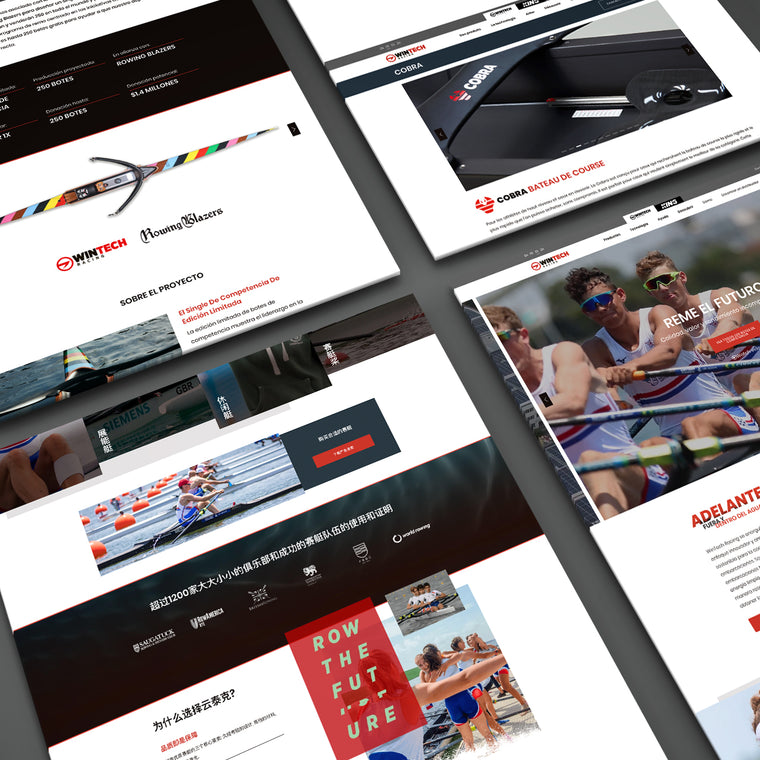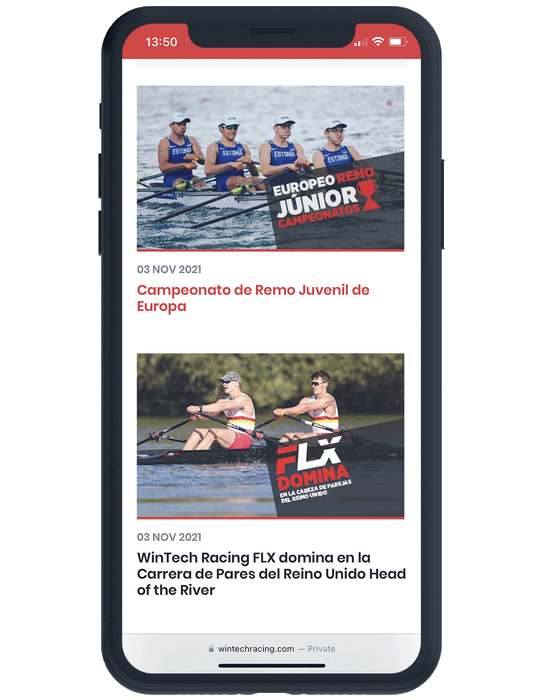WinTech Racing Internationalisation
Adding additional languages to internationalise WinTech Racing's online presence.
Services Used
Client Link

The site we built for WinTech Racing was doing well in English speaking countries but needed to be more prominent in other regions. We worked with their team around the world to create alternative language versions of the content that can be indexed by Google for people using those languages.
BRIEF
Language isn’t necessarily determined by where a user is in the world. They might be travelling abroad, for instance. Fortunately, we can detect their language preference as the site loads and then do one of two things: Automatically redirect them to what we think is the most suitable content version for them or suggest that they might want to view that content.
Following discussions with WinTech, we opted for a popup that shows if someone goes to a version of the site that doesn’t match their language preference.
The popup offers them a link to their preferred version of the new website, as well as the other languages available.
The site only shows this once, so it won’t become intrusive. We were also careful to link pages together. If the user has landed on a specific inner content page, selecting a different language version doesn’t drop them on the homepage for that language, but takes them to the translated version of the page that they wanted to read.
How does Google know which version to use, and not treat these pages as duplicate content? When we build international sites, we ensure that we add markers to tell Google that there are alternative language versions and the web address where it can find them.
We do this for every page so Google can build up a list of all the translated content for every page. This is done with hreflang tags. On the WinTech Innovation page, for example, we added this instruction:
link rel="alternate" href="https://data.wintechracing.com/es/tecnologia/innovacion/" hreflang="es-es"
This tells Google that a Spanish version (using the ISO language code ‘es-es’) of the site exists and lets it know where to find it.
We translate the web address of the pages as well - this further helps with SEO in that language and helps users understand where they are on the site.
Where this gets more complicated though is when working with Chinese. All the content was translated into Simplified Chinese, and this works perfectly for the page content. But if we just used the translated page title as the web address, we’d end up with something like wintechracing.com/zh/清漆艇, which most web browsers won’t understand.
For this we required the page titles to be translated into Pin Yin, which is a way of writing standard Chinese using letters from Latin-based languages (like English). We get the web address wintechracing.com/zh/sai-ting/ which keeps the browser happy and is much more useful to the reader than using the page title in English.
Although it’s not evident on the site, the WinTech Racing site manages all its content in a WordPress blog backend. This makes it easier for the team to maintain the site.
With a non-eCommerce site, it’s just content that needs considering. We used a well-established plugin that enables all content to have translated versions and establish links between those translated pages. The website itself is built using the Gatsby framework and this grabs all that content and packages it up into the different language versions.
eCommerce
So what about if you are running an ecommerce store? Well, that’ll depend on which platform you’re using:
Magento 2
In Magento, you can change the Locale of any Store View and with an added language pack, this will change the core text on the page (buttons, labels and so on).
The product information can be translated for each Store View so the title and description can be easily changed to a translated version in your admin area. Page content can be changed by creating a new page with the same URL key, but using the new language Store View and then the translated content can be added into that new page.
You’ll need to add a module to handle some of the SEO technicalities, but we’ll help you determine which one is best for you. Magento currency conversion is handled using exchange rates updated from external sources to keep them up to date, or you can set your own if you’d prefer. You set the base and default currencies that work for you, and you can choose which additional currencies you’d like to offer.
Shopify
All Shopify Plans above Lite allow multiple languages as part of the plan. You can create international domains to better target your customers and Shopify will take care of the technical bits (the hreflang tags and so on) all automatically for you.
Although Shopify will allow translations of the key parts of the site as standard (what it says on buttons, in emails, and in the checkout for example), to create translations of your content (such as the product’s description) then you will need to look at an app. One we often use allows you to translate your content using an AI to get it all in quickly, and then you can hand craft it from there with any native speaker to get it to match your brand’s tone of voice perfectly.
To sell in multiple currencies, you’ll need to be using Shopify Payments and once enabled most themes come with a currency converter (if yours doesn’t - let us know, we can add one very easily for you).
Shopify will handle the currency conversion for you - although you can set rounding rules so the prices look neater and more considered. On the Advanced or Plus plans you can set exact prices though if you’d prefer.
You can also set whether to include or exclude taxes in your pricing based on the customer’s location, so a UK customer would see pricing including VAT but a customer in Europe would see the VAT-free price. You just set which locations you want to include taxes and Shopify will handle it from there.
Delivery is also handled simply - you can create Shipping Zones which each have their own delivery options. So you could have a zone for mainland UK, and that might have a standard option and a next day option, and then you could have a zone for Europe that could have slightly longer delivery times for example. As with Magento, Shopify has a large number of shipping carriers that can easily be integrated into your store).
Not being confined to a geographical location is one of the great benefits of running an eCommerce store.
Widening that audience even further by greeting new customers in their own language and their own currency will make your offering much more appealing. The translation work does take some time, but once that’s done, it can be indexed by Google and the store will be ready to share with even more potential customers around the world.
We’ve just launched the Chinese version of the site in addition to the Spanish and French versions that we rolled out recently. German and Czech will be following shortly. It’s not a small undertaking, but the results are well worth it: Spanish visitors now account for over 9% of traffic, compared to virtually none for the same period last year.

TESTIMONIALS
"Adding additional languages to the site is a complex process but Absolute guided us through it and took care of all the technical considerations for us. They provided all the translation files needed with our translators and managed the whole process so no additional resource was required from us for the project."
Marketing Manager, WinTech Racing
As well as native apps for iPhone and Android we deliver solutions that can be deployed across platforms from a single codebase utilising frameworks such as React and Gatsby.

CASE STUDIES

Electrical Counter
Discover how we optimized Electrical Counter’s Adobe Commerce Cloud migration with a seamless Equinox ERP integration, 100K+ SEO-friendly redirects, and bespoke functionality for automation, pricing, and performance.
-
Magento

Dataman
We have worked with our long standing client Dataman, the leading supplier of device programmers, as they migrated from Magento to Shopify.
-
Shopify

